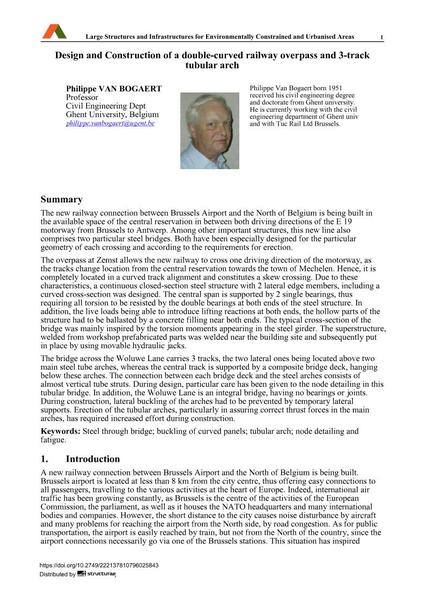Design and Construction of a double-curved railway overpass and 3-track tubular arch

|
|
|||||||||||
Bibliografische Angaben
| Autor(en): |
Philippe Van Bogaert
|
||||
|---|---|---|---|---|---|
| Medium: | Tagungsbeitrag | ||||
| Sprache(n): | Englisch | ||||
| Tagung: | IABSE Symposium: Large Structures and Infrastructures for Environmentally Constrained and Urbanised Areas, Venice, Italy, 22-24 September 2010 | ||||
| Veröffentlicht in: | IABSE Symposium Venice 2010 | ||||
|
|||||
| Seite(n): | 564-565 | ||||
| Anzahl der Seiten (im PDF): | 8 | ||||
| Jahr: | 2010 | ||||
| DOI: | 10.2749/222137810796025843 | ||||
| Abstrakt: |
The new railway connection between Brussels Airport and the North of Belgium is being built in the available space of the central reservation in between both driving directions of the E 19 motorway from Brussels to Antwerp. Among other important structures, this new line also comprises two particular steel bridges. Both have been especially designed for the particular geometry of each crossing and according to the requirements for erection. The overpass at Zemst allows the new railway to cross one driving direction of the motorway, as the tracks change location from the central reservation towards the town of Mechelen. Hence, it is completely located in a curved track alignment and constitutes a skew crossing. Due to these characteristics, a continuous closed-section steel structure with 2 lateral edge members, including a curved cross-section was designed. The central span is supported by 2 single bearings, thus requiring all torsion to be resisted by the double bearings at both ends of the steel structure. In addition, the live loads being able to introduce lifting reactions at both ends, the hollow parts of the structure had to be ballasted by a concrete filling near both ends. The typical cross-section of the bridge was mainly inspired by the torsion moments appearing in the steel girder. The superstructure, welded from workshop prefabricated parts was welded near the building site and subsequently put in place by using movable hydraulic jacks. The bridge across the Woluwe Lane carries 3 tracks, the two lateral ones being located above two main steel tube arches, whereas the central track is supported by a composite bridge deck, hanging below these arches. The connection between each bridge deck and the steel arches consists of almost vertical tube struts. During design, particular care has been given to the node detailing in this tubular bridge. In addition, the Woluwe Lane is an integral bridge, having no bearings or joints. During construction, lateral buckling of the arches had to be prevented by temporary lateral supports. Erection of the tubular arches, particularly in assuring correct thrust forces in the main arches, has required increased effort during construction. |
||||
